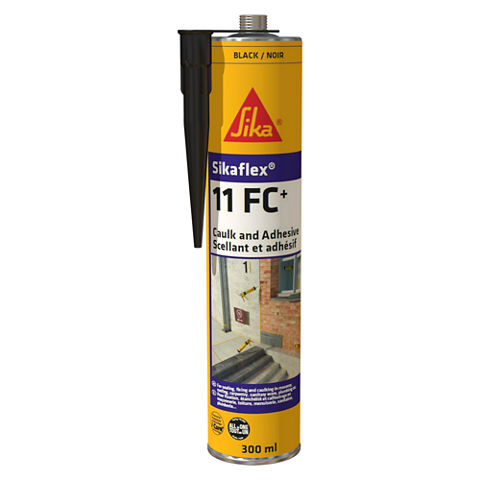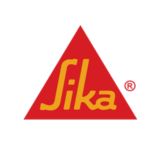
Sikaflex®-11 FC+
Sikaflex®-11 FC+ is a 1-part, multipurpose elastic adhesive and joint sealant with very good application properties which bonds and seals most construction material substrates. Internal and external use.
- Movement capability of ±35 %
- Bonds well to defined substrates without surface pre-treatment
- Good mechanical and weathering resistance
- Very low emissions
Usage
An adhesive to bond construction components and materials such as:- Concrete
- Masonry
- Reconstituted or cast stone
- Ceramic
- Wood
- Metal
- Glass
Advantages
- Movement capability of ±35 %
- Bonds well to defined substrates without surface pre-treatment
- Good mechanical and weathering resistance
- Very low emissions
Packaging
| 300 ml cartridges : 12 cartridges per box |
Colour
White, Black
Product Details
ENVIRONMENTAL INFORMATION
- Conformity with LEED v4 EQc 2: Low-Emitting Materials
APPROVALS / CERTIFICATES
- ASTM C920-11 class 35, Sikaflex-11 FC+, MST, Report
Composition / Manufacturing
i-Cure technology polyurethane
Shelf Life
15 months from the date of production
Storage Conditions
The product must be stored in original, unopened and undamaged packaging in dry conditions at temperatures between +5 °C and +25 °C. Always refer to packaging.
Density
| ~1,35 kg/l | (ISO 1138-1) |
Shore A Hardness
| ~37 (after 28 days) | (ISO 868) |
Tensile Strength
| ~1,5 N/mm2 | (ISO 37) |
Secant Tensile Modulus
| ~0,60 N/mm2 at 100 % elongation (+23 °C) | (ISO 8339) |
Movement Capability
| ±35 % | (ASTM C 719) |
Elastic Recovery
| ~80 % | (ISO 7389) |
Tear Propagation Resistance
| ~8,0 N/mm | (ISO 34) |
Service Temperature
−40 °C min. / +80 °C max.
Chemical Resistance
Resistant to many chemicals. Contact Sika® Technical Services for additional information.
Joint Design
The joint dimensions must be designed to suit the movement capability of the sealant. The joint width must be ≥ 10 mm and ≤ 35 mm. A width to depth ratio of 2:1 for facade joints must be maintained (for exceptions, see table below).
Typical joint dimensions for joints between concrete elements:
| Joint distance (m) | Minimum joint width (mm) | Minimum joint depth (mm) |
| 2 | 10 | 10 |
| 4 | 15 | 10 |
| 6 | 20 | 10 |
| 8 | 30 | 15 |
| 10 | 35 | 17 |
Minimum joint width for perimeter joints around windows is 10 mm.
All joints must be correctly designed and dimensioned in accordance with the relevant standards and codes of practice before their construction. The basis for calculation of the necessary joint widths are the type of structure, dimensions, technical values of the adjacent building materials, joint sealing material and the specific exposure of the building and the joints.
Joints ≤10 mm in width are for crack control and therefore non-movement joints.
For larger joints contact Sika Technical Services for additional information.
Application
Sag Flow
| ~1 mm (20 mm profile, +23 °C) | (ISO 7390) |
Ambient Air Temperature
+5 °C min. / +40 °C max.
Substrate Temperature
+5 °C min. / +40 °C max. Minimum +3 °C above dew point temperature
Backing Material
Use closed cell, polyethylene foam backing rod
Curing Rate
| ~3,5 mm/24 hours (+23 °C / 50 % r.h.) | (CQP* 049-2) |
*Sika Corporate Quality Procedure
Skinning time
| ~70 min (+23 °C / 50 % r.h.) | (CQP 019-1) |
Yield
| Bonding | |
| Yield 1 Cartridge (300 ml) | Dimension |
| ~100 spots | Diameter = 30 mm Thickness = 4 mm |
| ~15 m bead | Nozzle diameter = 5 mm (~20 ml per linear meter) |
| Sealing | |||
| Joint width mm | Joint depth mm | Joint length m per Cartridge (300 ml) | Joint length m per foil pack (600 ml) |
| 10 | 10 | 3,0 | 6,0 |
| 15 | 12 | 1,6 | 3,2 |
| 20 | 17 | 0,9 | 1,8 |
| 25 | 20 | 0,6 | 1,2 |
| 30 | 25 | 0,4 | 0,8 |
Consumption depends on the roughness and absorbency of the substrate.
These figures are theoretical and do not allow for any additional material due to surface porosity, surface profile, variations in level or wastage etc.
SUBSTRATE PREPARATION
The substrate must be sound, clean, dry and free of all contaminants such as dirt, oil, grease, cement laitance, old sealants and poorly bonded paint coatings which could affect adhesion of the adhesive / sealant. The substrate must be of sufficient strength to resist with the stresses induced by the sealant during movement.
Removal techniques such as wire brushing, grinding, sanding or other suitable mechanical tools can be used.
All dust, loose and friable material must be completely removed from all surfaces before application of any activators, primers or adhesive / sealant.
Contact Sika Technical Services for additional information.
CLEAN UP
Clean all tools and equipment with Sika® Urethane Thinner and Cleaner. Once hardened, product can only be removed mechanically. Wash soiled hands and skin thoroughly in hot soapy water or use Sika® Hand Cleaner towels.
Application Examples
FAQ
After the necessary substrate preparation, prepare the end of the cartridge / foil pack before or after inserting into the sealant gun then fit the nozzle. Apply in triangular beads, strips, or spots at intervals of a few centimetres each. Use hand pressure only to fix the components to be bonded into position before skinning of the adhesive occurs. Incorrectly positioned components can easily be unbonded and repositioned during the first few minutes after application. If necessary, use temporary adhesive tapes, wedges, or supports to hold the assembled components together during the initial curing time. Fresh, uncured adhesive remaining on the surface must be removed immediately. Final strength will be reached after complete curing of Sikaflex®-11 FC+, i.e., after 24 to 48 hours at +23 °C, depending on the environmental conditions and adhesive layer thickness.
The substrate must be sound, clean, dry, and free of all contaminants such as dirt, oil, grease, cement laitance, old sealants and poorly bonded paint coatings which could affect adhesion of the adhesive / sealant. The substrate must be of sufficient strength to resist with the stresses induced by the sealant during movement. Removal techniques such as wire brushing, grinding, sanding or other suitable mechanical tools can be used. All dust, loose and friable material must be completely removed from all surfaces before application of any activators, primers, or adhesive / sealant. Contact Sika Technical Services for additional information.
Do not expose uncured Sikaflex®-11 FC+ to alcohol containing products as this may interfere with the curing reaction.
Do not use Sikaflex-11® FC+ to seal joints in and around swimming pools.
Do not use Sikaflex-11® FC+ .on bituminous substrates, natural rubber, EPDM rubber or on any building materials which might leach oils, plasticizers or solvents that could degrade the adhesive. Also do not use Sikaflex-11® FC+ on polyethylene (PE), polypropylene (PP), polytetrafluoroethylene (PTFE / Teflon), and certain plasticized synthetic materials. Preliminary trials are recommended or contact Sika® Technical Services.
Full surface applications / fixing are not recommended since the inner part of the adhesive layer may never cure.
Always use Sikaflex®-11 FC+ in conjunction with mechanical fixing for overhead applications or heavy components.
Sikaflex-11® FC+ is resistant to many chemicals. Contact Sika® Technical Services for additional information. However, colour variations may occur due to the exposure in service to chemicals, high temperatures and/or UV radiation (especially with white colour shade). This effect is aesthetic and does not adversely influence the technical performance or durability of the product.
Sikaflex®-11 FC+ can be overpainted with most conventional water-based coating and paint systems. However, paints must first be tested to ensure compatibility by carrying out preliminary trials. The best over-painting results are obtained when the adhesive is allowed to fully cure first. Note: nonflexible paint systems may impair the elasticity of the adhesive and lead to cracking of the paint film.
~3,5 mm/24 hours (+23 °C / 50 % r.h.)
The ambient air and substrate temperature should be between +5 °C min / +40 °C max. The minimum temperature is 3 °C above the dew point temperature.
In addition, for good workability, the adhesive temperature must be at +20 °C.
Application during high temperature changes is not recommended (movement during curing).
For a 300 mL cartridge, the yield is ~100 spots if the diameter is 30 mm, and the thickness is 4 mm.
For a 300 mL cartridge, we obtain a ~15 m bead if the nozzle diameter = 5 mm (~20 mL per linear meter)
Typical joint dimensions for joints between concrete elements:
| Joint distance (m) | Minimum joint width (mm) | Minimum joint depth (mm) |
| 2 | 10 | 10 |
| 4 | 15 | 10 |
| 6 | 20 | 10 |
| 8 | 30 | 15 |
| 10 | 35 | 17 |
A width to depth ratio of 2:1 for facade joints must be maintained.
Joints ≤10 mm in width are for crack control and therefore non-movement joints.
Minimum joint width for perimeter joints around windows is 10 mm.
The joint dimensions must be designed to suit the movement capability of the sealant. The joint width must be ≥ 10 mm and ≤ 35 mm.
All joints must be correctly designed and dimensioned in accordance with the relevant standards and codes of practice before their construction. The basis for calculation of the necessary joint widths is the type of structure, dimensions, technical values of the adjacent building materials, joint sealing material and the specific exposure of the building and the joints.
For larger joints contact Sika Technical Services for additional information.
Do not use for trafficked floor joints. Contact Sika® Technical Services for advice on alternative products.
Do not use Sikaflex-11® FC+ for joints under water pressure or for permanent water immersion.
Yes, Sikaflex-11® FC+ is a sealant to seal vertical and horizontal joints.
